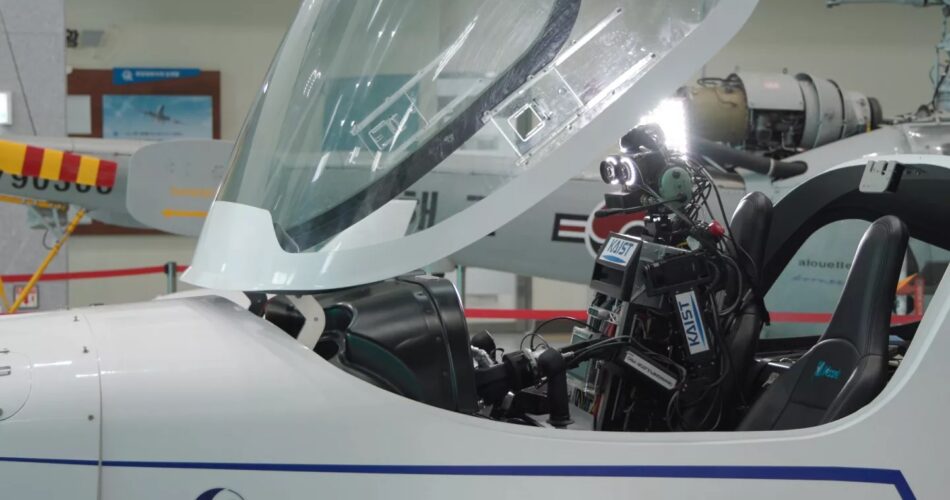It can safely pilot better than a human
Since robotics and artificial intelligence have advanced significantly in recent years, the majority of human employment may soon be replaced by technology, both on the ground and in the sky above us.
The Korea Advanced Institute of Science & Technology (KAIST) has a group of researchers and engineers working on a humanoid robot that can fly an airplane without modifying the cockpit.
“Pibot is a humanoid robot that can fly an aeroplane just like a human pilot by manipulating all the single controls in the cockpit, which is designed for humans”, David Shim, an associate professor of electrical engineering at KAIST, said.
Using high-precision control technology, the robot, known as “Pibot”, can deftly operate the flying instruments even in the presence of intense vibration in an aircraft.
Over the years, a number of robot pilots have been produced. In 2016, a human pilot was assisted by DARPA’s Aircrew Labor In-Cockpit Automation System (ALIAS) as they executed a few elementary in-flight maneuvers. The US Air Force hired RE2 Robotics to create the Common Aircraft Retrofit for Novel Autonomous Control (CARNAC) system, a drop-in robotic system meant to fly an unmodified aircraft, shortly after ALIAS used a simulator to land a Boeing 737. The ROBOpilot then completed its first two-hour flight in 2019.



These robot pilots differ from the one created by scientists at the Korean Advanced Institute of Science and Technology (KAIST) because PIBOT uses AI technology and is a humanoid. It is also a world-first because of the humanoid component.
Pibot can keep an eye on the aircraft’s condition thanks to its external cameras, and it can control key switches on the control panel with the aid of its inside cameras.
Pibot can memorize complex manuals written in natural language, which improves its ability to adapt to different aircraft. According to the KAIST researchers, its memory is so big that it can memorize every Jeppesen aeronautical navigation chart in the world, which is not conceivable for human pilots.
“Humans can fly many aeroplanes, but they do have these habits built into them. So when they try to convert to different aeroplanes they have to take another qualification. Sometimes this is not that simple because our habit remains in our mind that we can’t simply change from one to the other”, said Shim.
“With the pilot robot, if we teach individual aeroplane configuration, then you can fly the aeroplane by simply clicking the aeroplane’s type”, he added.
Because of recent developments in large language models (LLM), the study team claims Pibot “understands” and memorizes guides that were originally authored for humans.
“We had our predecessor of a pilot robot in 2016. At the time, we didn’t have good AI technology, so what we built was a simple robot. They cannot really learn anything from the literature or the manual. But recently with ChatGPT or with other large language model systems, the technology made paramount progress”, Shim explained.
LLM will allow Pibot to fly without making any mistakes and respond to emergencies far more quickly than its human counterparts. It has the ability to quickly recall aircraft operation and emergency manuals (such as QRH, an in-cockpit manual that the flight crew can consult in the event of an emergency while in flight). On the basis of the condition of the airborne aircraft, it may also determine a safe route in real-time.
The research team is employing ChatGPT while simultaneously creating and evaluating its own natural language model so that Pibot can ask questions without requiring an Internet connection. The specially designed language model, which may be transported onboard, will only deal with information related to piloting.
In order to communicate with aircraft directly, Pibot can also be plugged into them. This robot is currently intended for use in extreme circumstances where human involvement may not be advantageous. The humanoid robot may function as a pilot or first officer by speaking to air traffic controllers and other humans in the cockpit via speech synthesis.
Its flexibility extends outside of the aviation sector. Pibot, which stands 160 cm tall and weighs 65 kg, may easily take the place of people in jobs that require driving cars, handling tanks, or even running ships at sea because of its humanoid design.
According to Shim, this robot can be employed anywhere a person is currently “sitting and working”.
“The human form may not be super efficient but we specifically designed Pibot to be a humanoid form because all the things are built for humans. We can have eight arms and four eyes but we find the human form is somehow optimal”, Shim explained.
By 2026, the robot should be finished. According to KAIST, the study project was commissioned by the Agency for Defense Development (ADD), the government organization in charge of conducting research into defense technology in South Korea.
In the future, we could also see robots like this piloting military aircraft or maybe being used as soldiers as well as being used as pilots of a variety of transportation vehicles.
